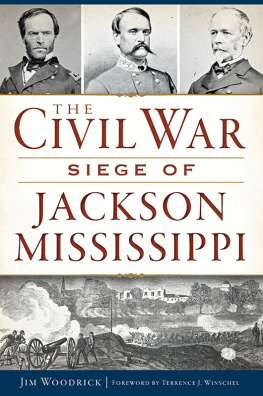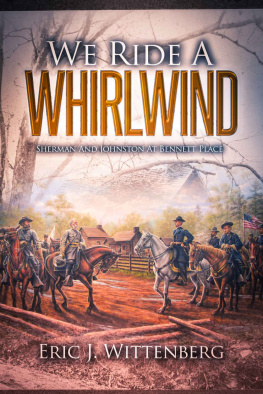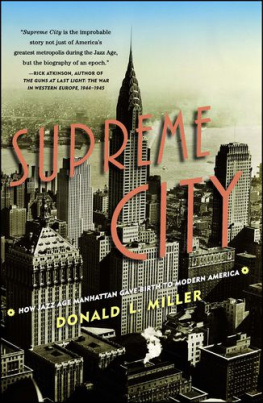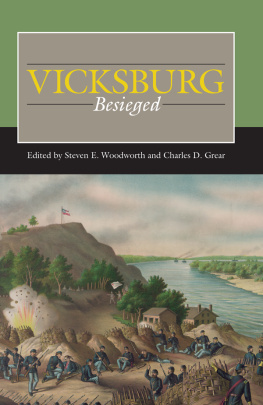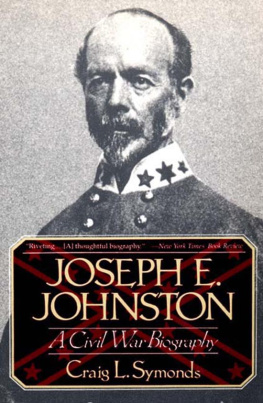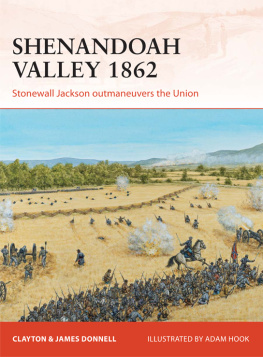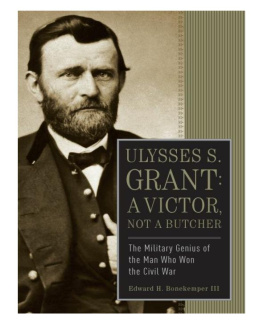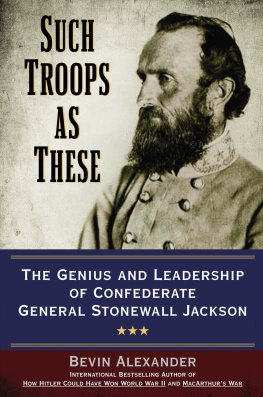
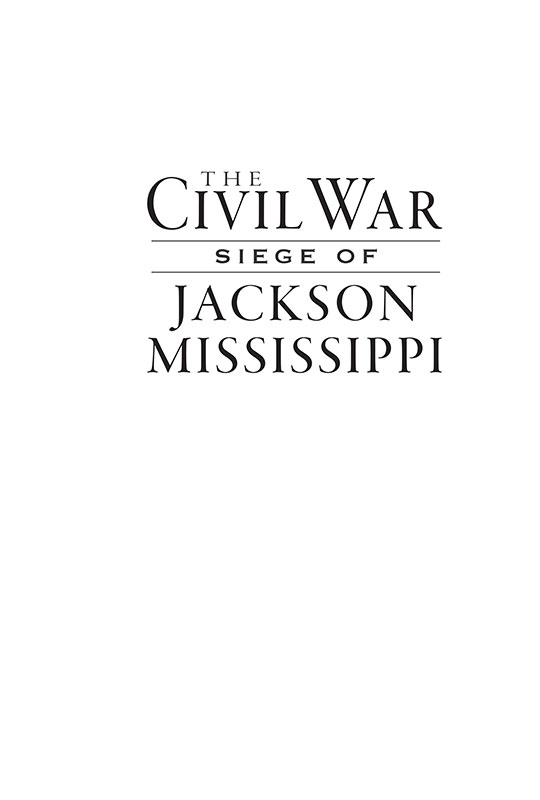
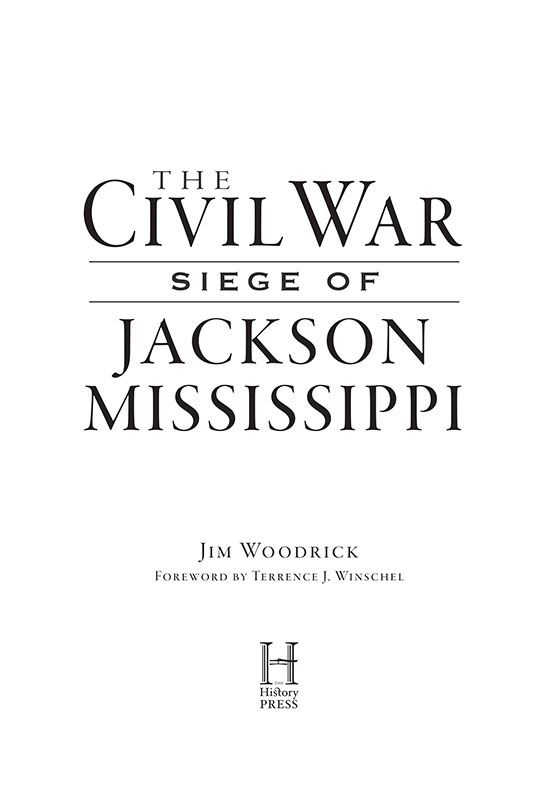
Published by The History Press
Charleston, SC
www.historypress.net
Copyright 2016 by Jim Woodrick
All rights reserved
First published 2016
e-book edition 2016
ISBN 978.1.62585.250.2
Library of Congress Control Number: 2015953414
print edition ISBN 978.1.62619.729.9
Notice: The information in this book is true and complete to the best of our knowledge. It is offered without guarantee on the part of the author or The History Press. The author and The History Press disclaim all liability in connection with the use of this book.
All rights reserved. No part of this book may be reproduced or transmitted in any form whatsoever without prior written permission from the publisher except in the case of brief quotations embodied in critical articles and reviews.
In memory of Warren E. Grabau
CONTENTS
FOREWORD
The campaign for control of the Mississippi River was perhaps the most decisive of the Civil War and one of the more complex military operations in the nations history. Waged over a thousand-mile front that stretched from Cairo, Illinois, to the Gulf of Mexico, the campaign pitted against one another significant land and naval forces of the North and South and included some of the wars most notable, colorful and even controversial figures.
Seared into the pages of history were the names of Grant, Sherman, Farragut, Porter, Beauregard, Albert Sidney Johnston and Joseph E. Johnston. Written in blood on those very same pages were names of places such as Fort Donelson, Shiloh and Vicksburg. The campaign culminated in July 1863, with the fall of the Confederate bastions at Vicksburg, Mississippi, on that Glorious Fourth, and Port Hudson, Louisiana, on July 9. The final, yet seldom-mentioned, scene of the great drama was enacted in Jackson, the capital city of the Magnolia State, in which the enigmatic Southern general Joseph E. Johnston and the once proud Confederate Army of Relief was compelled to evacuate the city following a short-lived siege (July 1017) by a Union expeditionary force led by William T. Sherman.
Other than a passing reference in association with the Vicksburg Campaign, the Siege of Jackson has garnered little attention in the everexpanding field of literature on the Civil War. Only one short and hard-tofind volume, titled The Battle of Jackson/The Siege of Jackson (Baltimore, 1981) by Edwin C. Bearss and Warren Grabau, documents this siege in any detail.
Almost forty years later, historian Jim Woodrick shines a bright and powerful light on the Siege of Jackson and the men in blue and gray who experienced war in all its pageantry and tragedy under a broiling Mississippi sun. Written with great skill and passion by one whose intimacy with the subject has no peer, this smooth-flowing and fast-paced narrative details the Jackson siege with clarity and precision. The author highlights the human pathos of battle through scores of previously untapped sources that will captivate and enthrall readers across the broad spectrum from novice to expert. In this volume, Woodricks mastery of the subject proves him worthy to document the Siege of Jackson, which stands equally worthy of his talented pen.
Terrence J. Winschel
ACKNOWLEDGEMENTS
A number of years ago, I was contacted by Warren Grabau, an eminent Civil War historian and author of Ninety-Eight Days: A Geographers View of the Vicksburg Campaign, about the possibility of revising a book he co-authored with Edwin C. Bearss on the Battle and Siege of Jackson. Published in 1981 by the Jackson Civil War Round Table, it is the only book-length treatment on the role of Jackson during the Civil War. Needless to say, I was thrilled with the possibility of working with Warren and eagerly agreed. Unfortunately, it was not long afterward that Warren passed away. With his death, I lost a longtime friend and mentor, but the idea of a new book on Jackson stayed with me. Over time, I decided to focus on the Siege of Jackson as a standalone event, not only because it was of particular interest to me, but because it has received relatively little attention while the Battle of Jackson, fought in May 1863, has been covered fairly extensively as part of the overall Vicksburg Campaign. This book is the result of Warrens idea. I can only hope I have in some small measure lived up to his expectations.
It is a daunting task indeed to try to thank all those who have played a role in making this book a reality. I would be remiss in not making the attempt, however. First and foremost, I want to acknowledge the monumental work of Edwin C. Bearss, whose extensive knowledge and research on the Vicksburg Campaign and the Civil War in general is the foundation for this and many other published works. Along with Ed Bearss, there are a host of historians who have not only contributed to the growing number of books on the Vicksburg Campaign but who have generously provided advice and support. In particular, I want to thank General Parker Hills and Terry Winschel for their willingness to share their encyclopedic knowledge and offer their sage advice throughout this project. Most of all, I value their kindness and warm friendship over the course of many years.
In compiling the information for this volume, I have had the pleasure of working with many wonderful people who have freely given of their time and resources. I am especially indebted to the staff of the Archives and Records Services Division of the Mississippi Department of Archives and History, particularly William Thompson and Jeff Giambrone; the Special Collections and Archives at the University of California, Riverside; the Special Collections Department of the McCain Library and Archives at the University of Southern Mississippi; Roberta Fairburn with the Abraham Lincoln Presidential Library in Springfield; Connie Langum, historian at the Wilsons Creek National Battlefield; Elizabeth Joyner, museum curator, Vicksburg National Military Park; George Bubba Bolm with the Old Court House Museum in Vicksburg; Captain William Carraway of South Carolina, who provided information on the history of the Twenty-sixth South Carolina Infantry; Shelby Harriel, Pearl River Community College, for information regarding the role of female soldiers at Jackson; Mary Woodward, chancellor of the Catholic Diocese of Jackson; Grady Howell, who seemingly knows all things related to Mississippis Confederate soldiers; Todd Sanders, for his knowledge of antebellum resources in Jackson; Mark Farrell, who generously provided access to the Henry Tisdale diary; and all those unnamed individuals at libraries and other repositories who have taken the time to scan so many wonderful primary resources and make them available via the Internet. Your work is of incalculable benefit and much appreciated. Most of all, I want to thank Richard Dortch of Jackson, whose passion for history is infectious and who has been more than generous in sharing his copious research.
I also wish to thank my colleagues in the Historic Preservation Division of MDAH. Their dedication to the cause of historic preservation is far too often an underappreciated public service to the people of Mississippi. In particular, I want to thank Jennifer Baughn, whose thoughtful observations and keen advice have been a source of inspiration throughout.
To my editors at Arcadia Publishing and The History Press, especially Candice Lawrence, I appreciate your patience, understanding and encouragement.
Next page
